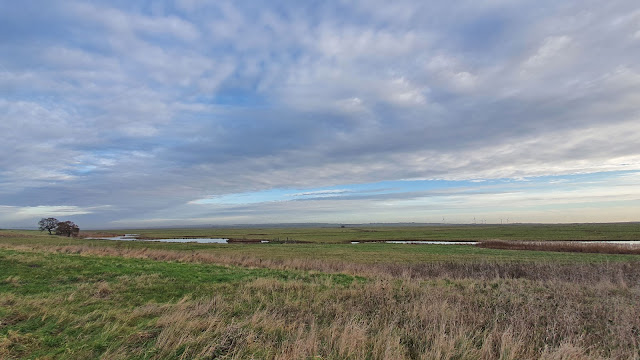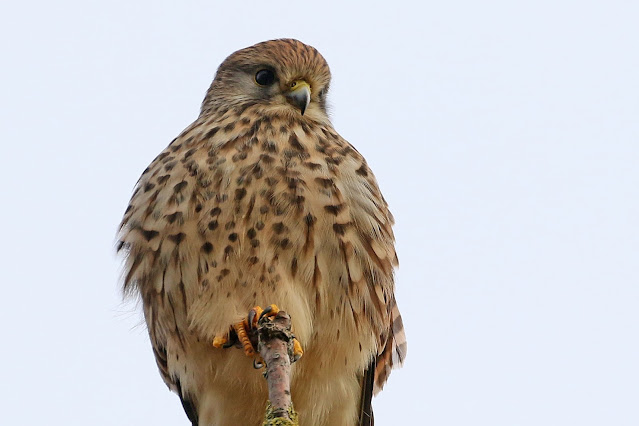The Isle of Sheppey is not the first place you might think of as a beautiful landscape. At the confluence of the Thames and Medway estuaries, it is low-lying and marshy, it was known by the soldiers posted here in the First World War as ‘mud island’. Indeed, remains of Sheppey’s 20th-century defences can still be seen in the remnants of concrete structures around the shore.
I was coming to the island to visit the Elmley National
Nature Reserve that can be found on the south side of the island, marshes that
follow the Swale estuary. Part of the
reserve was previously managed by RSPB but the entire management has now been
taken over by the Elmley Conservation Trust allowing the RSPB to free up
resources for other projects.
I last visited this reserve when it was known as a RSPB reserve
back in the early 1990’s, facilities were very basic then, although there were
hides. You always felt there was great
potential here but the area was so large and vast it always seemed to be a huge
challenge.
Somethings remain the same while others have changed since I
last visited in what was probably thirty years ago. The entrance to the reserve is now in the lee
of the tall-arcing Sheppey Crossing bridge.
Thirty years ago the only crossing was the swing bridge that also
carried the single track railway. That
bridge is still there as is the entrance track, in much better condition today
than back in the 1990’s. It is a two
mile drive from the entrance to the car park, this is situated next to the
Kings Hill Farm buildings that have been converted to a café, residential and
corporate event buildings.
I was here with Katie's partner Graham, a chance to introduce him to the isle and hopefully some special birds. It was the hope of being able to see some of the amazing numbers of raptors that have been reported here through the winter so far we were here, but, like last weekend it was the lure of the Short-eared Owl, reports of over six birds was like cat nip, and a visit to see my daughter allowed me the perfect opportunity.
As sorted myself out I noticed two large birds over the field to the south of the car park. Two Short-eared Owls were out already, but unfortunately a little way off to start with.
Elmley is not a natural marsh, it has gone through many
changes over the years. The sea wall was
built in medieval times, using spades. Then the Victorians ploughed the land up
for arable, using steam tackle. It fell into grass with the agricultural
depression that began in the 1880s. During the First World War, it was ploughed
up again; then went back to grass between the wars.’ The landscape today, with
its seemingly natural rills, is entirely artificial. ‘In summer, we have very
low rainfall. All the water has to be pumped on.’
The scrub around the car park is home to one or two Long-eared Owls during the day, but despite some very intense scouring we were not able to find any. It would seem that they haven't been visible for a few days.
The plan was to walk around the main path towards the hides, the area was one of ditches and patches of reed bed interspersed with grazing areas occupied by cattle and sheep. The high sea wall blocks any views of the Swale estuary, but every so often flocks of Brent Geese and probably Wigeon would fly over the wall and out onto the marsh. One of the more spectacular was this huge flock of Golden Plover.
Stonechat were all along the path, using the reed stems, grass and the fences as vantage points to watch for insects and other food opportunities.
The low sun was producing some wonderful light, the partially cloudy sky reflecting in the pools and ditches.
Just after the above photograph I picked up another Short-eared Owl hunting alongside the distant sea wall.
It followed the scrub and grass before flying up over the sea wall and down on to the saltmarsh, and out of sight of course.
A screen provided a view over the Swale, but with the tide out there was very little to see. We reached the main hides which are located around a series of scrapes, but decided to walk on. The distances on the signs appeared to be very optimistic and we decided in the end to not keep going. Out on the marsh Wigeon could be seen along with Greylag, Canada and Brent geese. It was when a Marsh Harrier would drift over that you suddenly appreciated the sheer number of wildfowl there was on the marsh.
From one of the hides the sun wasn't kind, but we were able to see duck on the water, again Wigeon, but also Shoveler, Teal and Gadwall. Buzzard and more Marsh Harriers could be seen on posts, but a long way off in the distance.
We decided to walk back to the car park, re tracing the path we had just come along. On the banks there were more Stonechat, but also Meadow Pipits and a few Reed Buntings.
The trick is to check the many posts and gates that remain on the marsh for anything that looks different. There are also quite a few old buildings and these too can be used as vantage points for the many raptors, on this one was a Marsh Harrier, which later flew low across the marsh scattering the duck and Lapwing.
It was very difficult to ignore a patch of reeds reflecting in one of the pools by the path.
So it was back to the car park and then a coffee in a very nice cafe, but it was a little short when it came to the menu. After warming up by the log burner we decided to walk along the path that leads from the farm down towards the Old School ruins and then on to the Swale.
The path passes the scrub grass that the Short-eared Owl like to hunt over, but there was no activity what so ever.
A Kestrel flew low over our heads being chased by a Magpie and flew up into a tree just in front of us. It didn't appear to be concerned about us at all and allowed us to get closer.
Then it flew off, landing in the top of the next tree, higher up this time but I was able to get underneath it and it seemed to be as interested in me as I was in it.
We left it at the top of the tree and walked down the path, ahead was a large patch of reeds and marsh, a pair of Marsh Harrier could be seen flying over the reed bed, the female heading away to the east while the male eventually gained height and drifted away towards the Sheppey bridge.
Stonechats were alongside the path, showing well perched on the reed stems and grasses.
Scanning across the marsh, once again there were raptors on fence posts. I was first alerted to a Buzzard on the left hand post, but a smaller bird on the right hand post was small and a closer view identified it as a Merlin.
I tried to get closer but while I wasn't looking it disappeared, it looked like a female bird, all brown. I am used to distant views of Merlin, it seems this is what they do. The Buzzard too, took to the air, joining two other birds circling above the marsh.
Walking back up the track a large flock of Lapwing appeared over the hill, the reason for them appearing then became clear as a Peregrine came low over the marsh and passed just to the left of us.
More gate posts and another revealed another small falcon perched, this time it looked to have a bluish hue although still a long way off, but definitely a different Merlin to the one seen earlier.
The Kestrel wasn't in the tree, but as we left the view of the Merlin, it appeared over the field hovering.
It then bank away.
And then hovering above me, concentrating on the rough grass to the other side of the path.
Then it dropped lower, clearly having seen something of interest. The images I took were in colour but in processing the images I have converted them to black and white. With the white sky the black and white looks really nice. I am showing both here to provide the comparison.
Finally, the Kestrel dropped like a stone into the grass, and stayed out of sight. I crept closer to where it landed and then suddenly it was up and was holding a vole in one claw. It flew to an old tree stump where it proceed to eat the unfortunate rodent.
We left the Kestrel once again and then headed back to the car park. Another search for the Long-eared Owls proved unsuccessful, but we were shown a roosting Short-eared Owl that was quite close to the car park. Chat with the locals revealed that there have been as many as ten owls present, quite amazing.
A Red Kite appeared above the car park, making it seven birds of prey for the day
Rain was coming so we decided to head back. But before we left we had a two mile drive back to the main road, this proved to be quite successful.
First a Cattle Egret feeding in a small pool quite close to the track. Cattle of course were close by
But the car proved to be too much for the egret and it was off.
A car was parked just off the track and as I approached I could see the reason, on a post, not to far from the track, was another Merlin, probably the third for the day.
I pulled over to allow me to get closer and to have a more stable base from which to photograph from. As I did so a male Marsh Harrier flew over.
This is the best view I have ever had of this diminutive little falcon. Other views have been in flight or very distant views that amounted to just a small blob that you had to convince yourself was a Merlin. This time though there was no doubt that this was a Merlin.




























































No comments:
Post a Comment